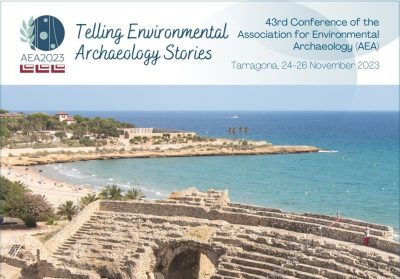
The Landscape Archaeology Research Group (GIAP) of the ICAC is coordinating the 43rd edition of the AEA’s annual conference, which will be held in Tarragona (Spain) on 24–26 November 2023.
The title for the conference is Telling Environmental Archaeology Stories, with which we aim to explore the contributions of environmental archaeology in creating history and how our research has helped explain and interpret the past.
The meeting will be held in Tarragona (Spain) on 24-26 November 2023. Registration will open soon, watch out for news on the conference webpage!
Abstract and call for papers
The interpretation of sites, soils, stratigraphies, cultural artifacts, and bioarchaeological remains using archaeological methods provides a rich source of material to investigate past behaviours and ultimately explain the human stories behind scientific data. The increasing interdisciplinarity and the development of new methodologies to treat archaeological primary data have opened new possibilities to deepen our interpretations and go one step further in understanding our cultural heritage.
Greater engagement in theoretical debates and approaches has further contributed to a multivocality and a proliferation of narratives that entangle different scales of analysis to explain the past. Environmental archaeology has made great strides, moving on from the ‘appendix’ of site reports listing species to occupying an important role and shedding light from different angles on key archaeological questions.
In this conference, we seek to explore the contributions of environmental archaeology to these ‘stories’ of the past. The aim will be to move the focus away from the data, techniques, and methodological advances to the narrative, to explore how our research has helped explain and interpret the past and which are our key contributions in creating history.
Another important area will be the examination of effective communication strategies of our stories and research achievements to colleagues of other academic fields and the public and how these can contribute real impact on modern society through either a better understanding of the past or lessons and practical guidance for the future.
We are calling for papers that employ environmental archaeology in its broader sense to investigate or propose new interpretations/hypotheses on:
- Social relations and the role of different social groups in shaping society and economy.
- The role of immigration/movement in changing society, how this took place, and its repercussions.
- Past cosmologies and belief systems.
- How people or groups of people perceived and acted on issues of health and medicine.
- How people or groups of people engaged with their environment: reconstructing rural or urban histories of interactions.
- People and societies as the main actors impacting landscapes, geographies, and environments.
- Local versus global narratives.
- Key events of the past (agricultural and farming developments, emergence of new forms of socio-economic organisation, and what these meant or how they changed life, etc.).
In relation to the theme ‘communicating environmental archaeology stories’, papers are also welcome on:
- Environmental archaeology contributions to policy making and impact.
- Successful stories of communicating and disseminating environmental archaeology research to researchers of other fields and the public.
- Environmental archaeology and the press.
- Environmental archaeology and impact on education.
- Inclusive environmental archaeology.
Presentation format
- Standard format: 15-minute presentations.
- Storytelling format: 6-minute presentations based on displaying images or using other visual means with commentary to ‘tell your story’. We suggest 2-3 slides per minute (20-30 seconds commentary per slide). The aim is to achieve a concise audiovisual presentation that will convey your aims, means, and achievements.
- Poster format: A1 size.
Submit your abstracts here: https://bit.ly/abstractsAEA2023
Deadline: 31 July 2023 23:59h CET
Preliminary conference schedule:
| Friday 24th (16-20 h) | Registration and opening session. To be followed by a wine reception. |
| Saturday 25th (08- c. 20h) | Registration and full-day conference including the AGM (AEA Annual Meeting); Gala dinner to follow. |
| Sunday 26th (08-14 h) | Morning sessions and closing of the conference. In the afternoon, guided tours of Roman Tarragona will be offered free of charge (prior registration required) |
Registration fees:
| Early bird (deadline 08/31/23) | Regular (deadline 10/31/23) | |
| AEA member | 80 € | 100 € |
| Non AEA member | 100 € | 120 € |
| AEA member student/unemployed/retired | 40 € | 50 € |
| Non AEA member student/unemployed/retired | 50 € | 60 € |
General info:
- Title: Telling environmental archaeology stories
- Dates: 24-26 November 2023
- Host institution: Catalan Institute of Classical Archaeology (ICAC), Tarragona, Spain
- Location: Palau Firal i de Congressos de Tarragona, c/ Arquitecte Rovira, 2, 43001 Tarragona
- Organisers: Landscape Archaeology Research Group (GIAP). In alphabetical order: Giannis Apostolou, Theoni Baniou, Lídia Colominas, Charlotte Diffey, Maria Ferrer Bonet, Abel Gallego, Darío Herranz Rodrigo, Alexandra Livarda, Alfredo Mayoral, Hèctor A. Orengo, Valentina Pescini
⇒ General queries about the conference can be addressed to: Maria Ferrer and Alexandra Livarda at aea2023@icac.cat
Come and visit Tarragona!
Tarragona is a port city located in northeast Spain by the Mediterranean Sea. Tarraco, as it was known in Roman times, provides an eloquent and unprecedented testimony to an important stage in the history of the Mediterranean in antiquity. In 2000, UNESCO declared its archaeological sites a World Heritage Site.
Tarraco was a little Rome, open to the Mediterranean and with a particularly pleasant climate, that is, a good place to live and prosper. This is still the spirit of the city today. Walking through the streets and squares of the medieval city or contemplating the horizons over the Mare Nostrum, you can relive the pleasant and beneficent city that has inspired travelers, artists & chefs. In Tarragona, history comes out of stones and books and comes to life in its people, cuisine, and landscapes.
This still holds true nowadays, with the NYTimes including Tarragona as one of the 52 places to go in 2023.





